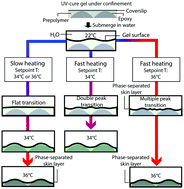Patterning non-equilibrium morphologies in stimuli-responsive gels through topographical confinement†
Abstract
Stimuli-responsive “smart” polymers have generated significant interest for introducing dynamic control into the properties of antifouling coatings, smart membranes, switchable adhesives and cell manipulation substrates. Switchable surface morphologies formed by confining stimuli-responsive gels to topographically structured substrates have shown potential for a variety of interfacial applications. Beyond patterning the equilibrium swelling behavior of gels, subjecting stimuli-responsive gels to topographical confinement could also introduce spatial gradients in the various timescales associated with gel deformation, giving rise to novel non-equilibrium morphologies. Here we show how by curing poly(N-isopropylacrylamide) (pNIPAAm)-based gel under confinement to a rigid, bumpy substrate, we can not only induce the surface curvature to invert with temperature, but also program the transient, non-equilibrium morphologies that emerge during the inversion process through changing the heating path. Finite element simulations show that the emergence of these transient morphologies is correlated with confinement-induced gradients in polymer concentration and position-dependent hydrostatic pressure within the gel. To illustrate the relevance of such morphologies in interfacial applications, we show how they enable us to control the gravity-induced assembly of colloidal particles and microalgae. Finally, we show how more complex arrangements in particle assembly can be created through controlling the thickness of the temperature-responsive gel over the bumps. Patterning stimuli-responsive gels on topographically-structured surfaces not only enables switching between two invertible topographies, but could also create opportunities for stimuli ramp-dependent control over the local curvature of the surface and emergence of unique transient morphologies. Harnessing these features could have potential in the design of multifunctional, actuatable materials for switchable adhesion, antifouling, cell manipulation, and liquid and particle transport surfaces.



 Please wait while we load your content...
Please wait while we load your content...